This January and February, we’ll be finishing up our look at the second season of Star Trek: The Next Generation and moving on to the third year of the show, both recently and lovingly remastered for high definition. Check back daily for the latest review.
We’ll be supplementing our coverage of the episodes with some additional materials – mainly novels and comics and films. This is one such entry.
It’s amazing that Assimilation² represents the first official crossover between Star Trek and Doctor Who. After all, the nineties saw a trilogy of comics and novels in which Star Trek crossed over with Marvel’s X-Men. At the same time, though, the miniseries’ combination does seem a little odd. Pairing the Cybermen and the Borg is a bit of a no-brainer, but the Eleventh Doctor feels like a bit of a strange fit on board Picard’s Enterprise.
The Ninth or Tenth would arguably offer more of a contrast with Picard’s restrained and dignified command style. The Tenth Doctor and Donna arriving on the luxury Enterprise practically writes itself. (“Now that’s what I call a spaceship. You’ve got a box, they’ve got a Stella Liner.”) Picard and the Eleventh Doctor feels like a particularly bland pairing, if only because there’s no way they’d try each other’s patience. The Eleventh Doctor would probably work better in the context of Sisko’s Deep Space Nine or either Kirk’s Enterprise.
Still, although Assimilation² never quite takes full advantage of its central hook, it’s a diverting enough mish-mash of two science-fiction staples.
To be fair, the two shows have been ripe for crossover from the moment that The Man Trap hit the air. Star Trek was one of the defining American science-fiction shows of the sixties, just as Doctor Who was one of the defining British science-fiction shows of the era. The two series have undoubtedly had a massive influence on one another as they’ve grown and evolved over the years. After all, both franchises have endured – in one form or another – for half a century.
Some of these similarities are undoubtedly coincidence or parallel development. The portrayal of space as cold and empty and horrifying in the first season of Star Trek and Patrick Troughton’s time on Doctor Who is mostly likely down to the fact that, in 1965, the Mariner 5 probe had reported that Mars was completely devoid of life. However, there’s also an argument to be made that Star Trek‘s focus on space empires and federations had an influence on the Pertwee era’s fixation on the same in the seventies. (Although the looming possibility of a united Europe was undoubtedly a contributing factor.)
There is more direct evidence of mutual awareness (and even cross-contamination) in later shows and series. From the eighties onwards, both shows are explicitly aware of one another. The Neutral Zone, the final episode of the first season of The Next Generation, has the crew of the Enterprise studying a readout listing the first seven lead actors from Doctor Who. Appropriately enough, this was the first episode to hint at the existence of the Borg.
When the revived Doctor Who came back, writer Steven Moffat was extremely fond of making jabs at Star Trek. In a line cut from the final episode, the recurring “Mister Spock” gag from The Empty Child and The Doctor Dances was supposed to pay off with the Doctor saying “I’d rather have Doctor Who than Star Trek.” Moffat’s first Christmas special, A Christmas Carol, has the Doctor saving a “galaxy-class” starship, piloted by characters who superficially resemble Geordi and Data.
The first producer of the revived Doctor Who apparently considered attempting a crossover between Doctor Who and Star Trek: Enterprise. Given Russell T. Davies’ tendency for exaggeration and love of stirring the internet, it’s hard to know how serious he was, but he suggests it never got past the idea phase:
I would have loved to have done a Star Trek crossover. The very first year, we talked about it. Then Star Trek finally went off air. Landing the TARDIS on board the Enterprise would have been magnificent. Can you imagine what their script department would have wanted, and what I would have wanted? It would have been the biggest battle.
Unfortunately, Enterprise was cancelled before the idea could be pursued further. For what it’s worth, the second season of Enterprise did feature a shout-out to Doctor Who. In Future Tense, the crews discover a time-travelling ship that is bigger on the inside. Writer Mike Sussman jokes, “My idea of the ship morphing into a police call box was immediately nixed by the producers!”
Still, the practical overlap between Star Trek and Doctor Who remains minimal. The most obvious reason is that the shows were seldom on the air simultaneously. The original Star Trek aired during Patrick Troughton’s tenure on Doctor Who, but most of the rest of classic Doctor Who aired while Star Trek was being kept alive through novels and feature films. When The Next Generation hit the airwaves, Doctor Who was on its last legs. It would be cancelled early in The Next Generation‘s third season.
By the time that The Next Generation had entered its stride, Doctor Who had finished. Doctor Who was mostly off the air during the heyday of Star Trek in the nineties. Barring the abysmal TV Movie, Doctor Who was completely absent during the broadcast of Star Trek: Deep Space Nine or Star Trek: Voyager. Russell T. Davies finally managed to get the revival of Doctor Who off the ground in 2005, with the first season airing just as Enterprise was cancelled.
So there’s never really been an extended period of coexistence between the two franchises. Still, the links and influences and overlaps are frequently discussed. As you might expect, the Borg and Cybermen – the villains of Assimilation² – are often at the core of the discussion. Both are alien menaces that seem to “convert” humanity into inhuman cyborgs. The Cybermen are human brains preserved inside mechanic shells, but the Borg are more of a hybrid.
Much has been made of how the creation of the Cybermen may have influenced the Borg. People frequently point to the reference to Doctor Who hidden in plane sight in The Neutral Zone as evidence that the production staff on The Next Generation knew what they were doing. The Neutral Zone was the episode that hinted towards the Borg, revealing a bunch of missing Federation and Romulan bases abducted by an as-yet-unknown assailant.
Of course, it’s not quite as simple as all that. When The Neutral Zone was written, writer Maurice Hurley was still imagining the Borg as an insectoid hive mind – so it’s unlikely the shout-out was a piece of foreshadowing from the production team. Even after the concept of the Borg was revised to the version fans have come to know and love, it’s still worth noting that Cybermen aren’t the first cyborgs to exist in popular culture.
Indeed, there’s a long and rich history of cyborgs in fiction that the writers could have been drawing from. The cyborg as a concept dates back to least the 1877 short story The Ablest Man in the World, about a man who installs a computer in his brain. At the same time, though, it is quite easy to draw connections between the Borg and the Cybermen, conceptually. “All resistance is useless,” the Cybermen intone in 1967’s The Moonbase.
It’s entirely possible that the Borg evolved independently as a concept, but it’s also quite likely that there is some evolutionary link between the two. Although it is worth noting that Q Who? suggests that the Borg are not interested in converting individuals, only technology. The concept of individual “assimilation” came later, suggesting that it grew organically from the concept of the Borg, rather than being created as a parallel to “cyber conversion.”
Either way, we’ll likely never know for certain just how profoundly the Borg were influenced by the Cybermen. With the Cybermen, Kit Peddler managed to tap into a very powerful subconscious fear, and it’s entirely possible that the writers of The Next Generation just tapped into that fear two decades later. After all, in the gap between The Tenth Planet and Q Who?, the entire cyberpunk genre had come into existence, and the notion of cyborgs had become a lot more popular and recognisable, with shows like The Six Million Dollar Man and movies like Terminator familiarising the public with the concept.
Arguably, whatever influence there may have been has come a full circle. It has been suggested that the version of the Cybermen reinvented for Davies’ Doctor Who revival owe a conscious debt to the Borg. In The Greatest Show in the Galaxy: The Discerning Fan’s Guide to Doctor Who Marc Schuster, Tom Powers contends:
This new generation of Cybermen, moreover, represents an improvement over previous models in that gold is not a threat to their respiratory mechanisms, and they are far less prone to internal bickering as their counterparts in the classic series. For example, where the Cyber Leader in Silver Nemesis must silence one of his dissenting lieutenants with the admonition that he is acting “outside [his] function”, the Cyberman of The Age of Steel are more akin to the Borg of Star Trek fame in their adherence to a hive-like, singular mindset. “We think the same … We are uniform,” one Cyberman explains when Cyber-creator John Lumic ponders the essence of Cyber-being, and this attitude is confirmed by repeated shots of Cybermen marching, dozens at a time, in perfect lockstep.
It would appear that the Borg Collective may have become an influence in the portrayal of the Cybermen themselves.
Indeed, the recent attempt to reinvent the Cybermen in Nightmare in Silver invited all sorts of comparisons to the Borg. For what it’s worth, writer Neil Gaiman himself – tasked with making the Cybermen scary again – has rejected any direct Star Trek influence, but does concede the possibility of parallel evolution:
One of my great embarrassed admissions – and I have very few – is that, while I have seen every episode of the original Star Trek many times, and could quote you the entirety of The Trouble with Tribbles with my eyes closed, Star Trek: The Next Generation happened during a period where I was moving from the U.K. to the U.S. For a big wedge of that time, I had no access to television because we were too far out in the country, so I missed it. It happened in the background and I didn’t actually ever get to watch it. I started catching up with television again with Babylon 5, mostly because I was asked to write an episode. So, I missed the Borg and only knew about them, way in the background. I suspect this is more a case of a certain amount of parallel evolution. But, I would love to reclaim the cybernetic menace crown.
So, it would seem that the Borg and the Cybermen have come something of a full circle with one another.
What is interesting is that – since the sixties – the Cybermen have really been defined as a secondary threat in Doctor Who. They are the villains who show up when you can’t get the Daleks. They are a recognisable and easy-to-defeat foe, and can often be slotted quite easily into an existing story without warping the narrative too much. Indeed, when Russell T. Davies had the Cybermen confront the Daleks in Doomsday, it ended with the mass slaughter of the Cybermen at the hands of Doctor Who‘s truly iconic villains.
In contrast, the Borg are the big baddies of modern Star Trek. They were responsible for The Next Generation‘s first proper cliffhanger ending. They were the stars of the most critically successful Next Generation film. They appeared in the last episode of Star Trek: Voyager. Their catchphrases are iconic. They are among the most recognisable aliens in the franchise, and they are frequently suggested for inclusion on JJ Abrams’ rebooted Star Trek film franchise.
So Assimilation² is interesting in that it treats the Cybermen as the primary threat. The Cybermen betray the Borg and prepare to wipe out the Collective. The Cybermen are the threat to the multiverse. “They have much in common with the Borg,” Guinan tells us, “but the Cybermen do not limit their plans for conquest to a single universe.” Of course, the Borg don’t limit their plans to a single universe either. That was the entire point of Scorpion.
The focus that Assimilation² gives to Doctor Who is interesting. After all, the primary writers on the series (Dave and Scott Tipton) are primarily known as the writers of IDW’s Star Trek comics. Star Trek: The Next Generation is given top billing on the crossover. The story is set primarily in the Star Trek universe, with the Doctor and the Cybermen guests in this most elaborate of set-ups.
And yet Doctor Who is very much the stronger narrative here. The Cybermen best the Borg. They are prompted to betray their former allies by the arrival of “a random, powerful element” – the Doctor. The comic opens with a stand-alone adventure featuring the Doctor and the Ponds. Even an iconic piece of Star Trek lore – the Battle of Wolf 359 from The Best of Both Worlds – is re-contextualised within the framework of Doctor Who. It is an “echo” of the “Bad Wolf” from The Parting of the Ways.
To be fair, this focus is understandable. While the Eleventh Doctor was very much an on-going concern when Assimilation² was published, The Next Generation had been confined to history. The first issue of Assimilation² was released as the reissue of the first season of The Next Generation on blu ray was imminent. The last issue came out the same month as the second season blu ray of The Next Generation. As such, it’s understandable that Star Trek feels somewhat secondary to the narrative here.
It’s a story for the Doctor and the Cybermen to collide with, rather than an equal partner. Given the fixation of the Eleventh Doctor’s era on stories and fairy tales, The Next Generation becomes yet another story to survive a collision from the Doctor. Appropriately enough, the Doctor lands on the holodeck, as the crew are working through a Dixon Hill holo-novel. Stories within stories within stories.
Appropriately enough, the Doctor arrives as something of a critic. He spends a significant amount of time criticising the Star Trek narrative conventions – even getting to do his standard “no guns” routine with Worf. When he arrives on the Enterprise, one of the first things that he does is to voice one of the more popular criticisms of The Next Generation, particularly when contrasting Star Trek with Doctor Who. It’s all too tidy, too neat, “… too perfect. Reality is always much messier.”
To be fair, there are some nice moments here. The Tiptons do slide in a few nice bits of foreshadowing and hinting. The Borg’s solution to the problem presented by the Cybermen seems to mirror the approach they would eventually adopt to the Federation in David Mack’s Destiny trilogy. “Assimilation of the Cybermen was attempted,” the Borg advise the Enterprise crew. “It was not possible. Eradication is required.”
Similarly, the Borg make an interesting affront to the Doctor’s morality. It’s arguably not too distinct from the moral issues raised by the Cybermen, but it’s nice to see the threat of the Borg defined in terms of Doctor Who. The Borg aren’t offensive because they are inhuman or alien. They are offensive because they challenge every being’s right to freedom and self-identification. “It’s slavery all right,” the Doctor notes. “Slavery from the inside, a most devious form of bondage.” It’s a nice demonstration of how the Borg would work as a Doctor Who baddie.
Still, a lot of Assimilation² feels a bit like a wasted opportunity. Given the incredible span of fictional history that exists in both Doctor Who and Star Trek, it seems weird that we spend so much time stuck on Picard’s Enterprise with the Eleventh Doctor. The third issue takes a charming diversion into a tale of classic Cybermen intersecting with classic Star Trek, but the scope of Assimilation² feels rather limited for an eight-issue series.
Give us the Eleventh Doctor flirting with Janeway! The Seventh Doctor scheming with Garak! The First Doctor snarking with Leonard McCoy! The Fourth Doctor messing with Data! The Fifth Doctor being charmingly ineffective with Archer! The potential is limitless. As charming as the union of the Borg and the Cybermen might be, it feels a little much for an eight-issue miniseries. There are some nice character moments along the way (Rory geeking out over 24th century technology, Deanna actually doing some counselling with Amy), but they tend to get a bit a lost in the mix.
Assimilation² is a fairly solid crossover, and one that hits quite a few of the necessary boxes. Unfortunately, it feels just a little bit too by-the-numbers, a little too perfunctory.
Read our reviews of the second season of Star Trek: The Next Generation:
- The Child
- Supplemental: Phase II (1978) – The Child
- Where Silence Has Lease
- Elementary, Dear Data
- Supplemental: Embrace the Wolf
- The Outrageous Okona
- Loud as a Whisper
- The Schizoid Man
- Unnatural Selection
- Supplemental: Deep Space Nine (Marvel Comics) #3-4 – The Cancer Within
- A Matter of Honour
- The Measure of a Man
- Supplemental: Myriad Universes – Echoes and Refractions: Brave New World by Chris Roberson
- Supplemental: The Measure of a Man (Extended Cut)
- The Dauphin
- Supplemental: Masks by John Vornholt
- Contagion
- The Royale
- Time Squared
- The Icarus Factor
- Supplemental: The Lost Era – Deny Thy Father by Jeff Mariotte
- Supplemental: (DC Comics) Annual #2 – Thin Ice
- Pen Pals
- Q Who?
- Supplemental: Strange New Worlds VI – The Beginning by Anne Reed
- Supplemental: Star Trek: The Next Generation/Doctor Who – Assimilation²
- Supplemental: The Newspaper Strips – Beware the Omnimind! (aka Restructuring is Futile)
- Samaritan Snare
- Up the Long Ladder
- Manhunt
- The Emissary
- Peak Performance
- Shades of Grey
Filed under: Comics, The Next Generation | Tagged: assimilation, Assimilation², borg, comic books, crossover, cybermen, dave tipton, doctor who, idw, scott tipton, star trek, star trek: the next generation, the next generation, tng |















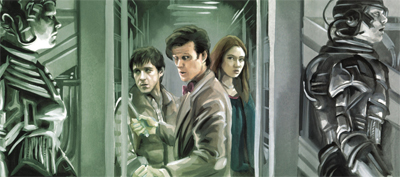
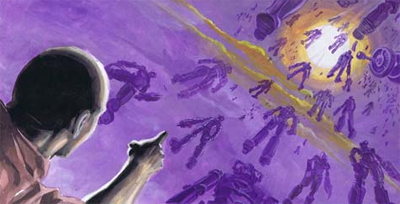
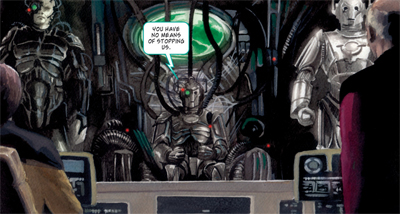
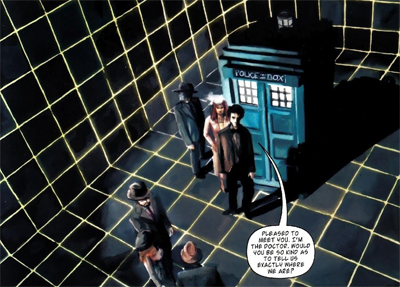
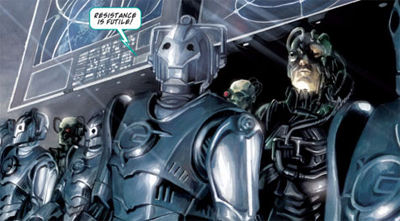
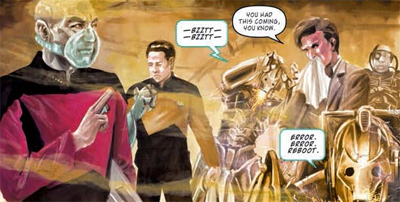
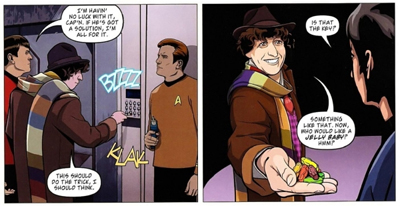
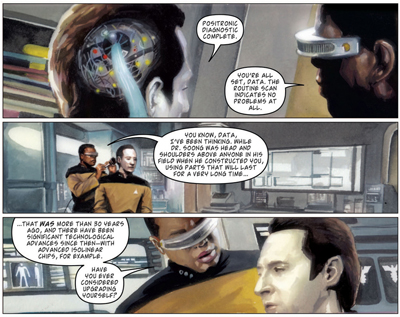

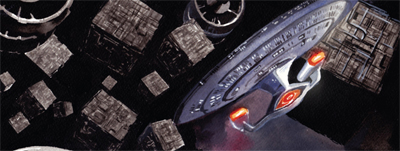
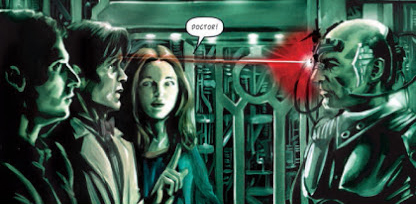
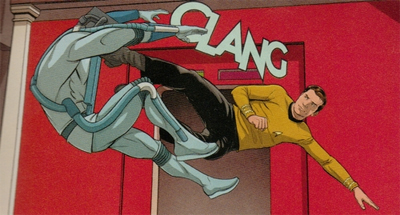
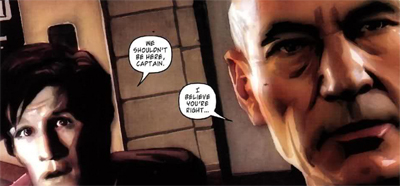
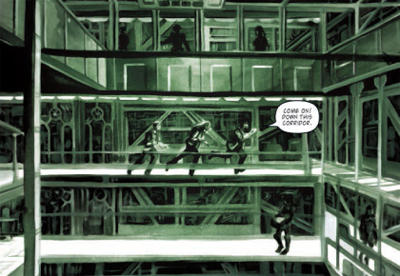
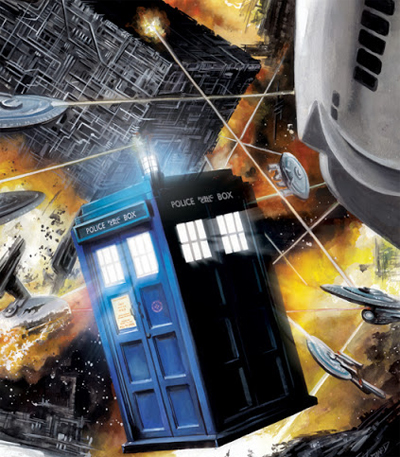
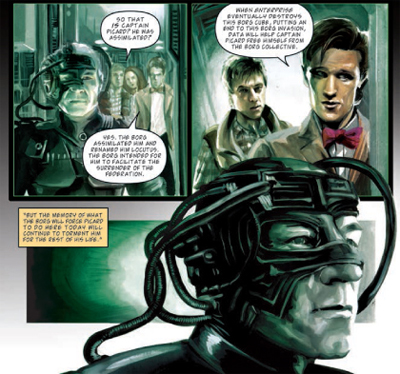





The series felt a little serious. TNG could get self-serious at times. But one would expect the union of Star Trek and Doctor Who to be a bit more buoyant. Maybe the somber paintings on every page contributed to the heaviness. Once Kirk showed up, and the art style transitioned into a brighter, more traditionally comic, tone, the whole piece lifted. For that issue we got a taste of what this series could have been.
I like your list of suggested stories! Those could be great!
I actually loved that Kirk sequence, and would have adored a sequence of one-shots with combinations and crossovers. Fun stuff like that.
You’re right that it’s very serious, but I think that’s the problem with doing the Borg and the Cybermen, as logical as that crossover is. The Borg are very serious business, and so need to be treated as such – they represent impressive stakes and huge losses. The Cybermen, on the other hand, are defeated by the Doctor going under cover at a department store and are massacred by four Daleks.
It would be a lot less iconic, but it might have been fun to see the Cybermen teaming up with Vaal or such – one of the sixties crazy super computers, if only because the Cybermen are a concept that really worked best in the sixties style. The Troughton era was really the Cybermen’s heyday. (The Borg were really the best upgrade the Cybermen never had, as the show has conceded with the nods – intentional and otherwise – to the Borg in its attempts to update the Cybermen since the 2005 revival.)
I’m surprised there isn’t more crossover between Star Trek and Doctor Who considering that Doctor Who is exactly the kind of Mischievous Meddlesome Supreme Being that the crews of the Enterprises were always running across, like Q and all his TOS counterparts.
On the other hand, I think that’s one of the problems with crossing them over.
The Doctor is, as you note, one of those “Mischievous Meddlesome Supreme Beings” that the Enterprise struggled with from time-to-time. Answerable to nobody, prone to bring chaos on a whim.
However, the Federation is also worryingly close to one of those totalitarian regimes that the Doctor routinely overthrows. No rights for androids to prevent unsafe experiments and plans to build an army of worker drones? Children not supposed to be upset at the death of their parents? Smug superior attitude towards the Ferengi? Nobody allowed a dissenting opinion? Engaged in a Cold War with the Romulans and Cardassians? It’s not too hard to believe that the Doctor would have serious ethical problems with the Federation.
Of course, those are two exaggerated opinions (in most cases, the Federation very slowly learns its lessons), but it does suggest that there should be more friction than “the two meet up and everybody gets along.”
I always thought the Federation was meant to be this utopian democracy, and that most of those things you list were just Gene Roddenberry going way too far, and that stuff was abandoned early on. It doesn’t come off as totalitarian to me, especially compared to actual totalitarianism we’re living under today. I admittedly love the condescending attitude toward Ferengi btw, since it’s anti-capitalist, the only problem is the Ferengi are an idiotic concept, a race of capitalists makes no sense. DS9’s Ferengi are a tiny bit more believable, even if they come off as a bunch of jewish stereotypes.
To answer the other guy, according to Memory Alpha, IDW planned a DS9/Doctor Who follow-up as a sequel, but for whatever reason they shitcanned it.
I suspect that losing the Doctor Who license to Titan probably put the kaboosh on that.
“one of the first things that he does is to voice one of the more popular criticisms of The Next Generation, particularly when contrasting Star Trek with Doctor Who. It’s all too tidy, too neat, ´… too perfect. Reality is always much messier.´”
I always thought that, what might explain why my favourite Star Trek series is Deep Space Nine. A lot messier, we see the “not so much bright” side of the Federation in the war against the Dominion.
I agree with this a great deal. DS9 held on to Roddenberry’s idealism, but realised that while people might become better, the universe will never be the paradise that allows everybody to be the best that they could every be at every possible moment. It’s ambitious enough to hope that we can be substantially better, and that we can face these sorts of problems without sacrificing our basic decency.
Ironically, as one article points out (http://badartworld.net/index.php/2016/11/25/socialism-in-space/), DS9’s writers (or some of them anyway) hated the supposed socialist vision of Trek, and thought they were taking a giant crap all over it with DS9, but ironically DS9 made the show’s vision come off as an actual socialist vision (class struggle for example, people rising up from their petty beliefs, ferengi going on strike and quoting the communist manifesto…) as opposed to the secular humanist liberalism of NextGen. DS9 does a lot of stupid shit though too, mainly its angle on religion, which ended with Sisko becoming literal space Jesus fighting Satan. Lol..
Oh as for this comic, I like it a lot. It’s not a compelling story, but what can you expect from what’s essentially fan fiction? The art is nice and I love some of the recreations of Best of Both Worlds. It’s a nice way of marrying the Cybermen and the Borg.
I like these crossovers. Is the plot silly and contrived? Yes, but so what? It’s fun to see two of my favorite sci fi franchises collide 😛